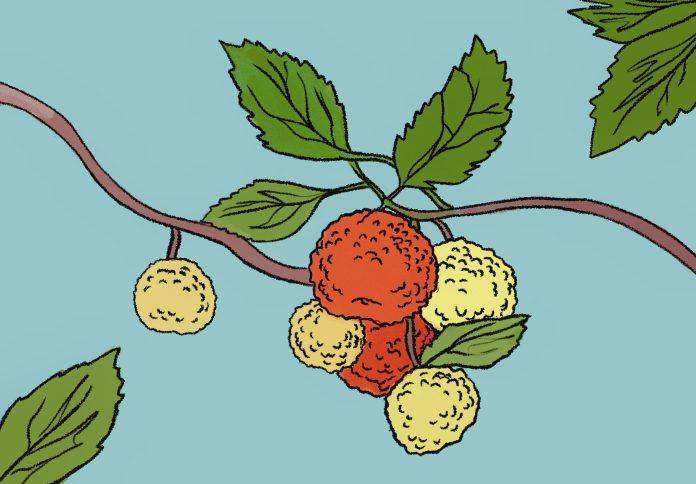Melanie Martinez
Science & Tech Editor
On the way to class you may have noticed some trees with berries of shades varying from orange to red. Arbutus unedo, or otherwise known as the “strawberry tree,” is passed by hundreds of UC Santa Barbara students on their daily commute. While the tree may not produce actual strawberries, it does produce round brightly-colored berries. The berries that hang from the tree’s branches are actually edible and, with a rough exterior and taste similar to a pear, make for a perfect snack in between classes.
The tree itself is native to Southern Europe and Ireland but is acclimated to a variety of climates. An established tree can withstand certain weather conditions, like droughts, but it can’t withstand severe dry periods, especially when it is young. Arbutus unedo can also thrive in urban areas, including university campuses such as UCSB.
The strawberry tree can grow up to 35 feet tall with a canopy of 20-35 feet. The tree is noted for the charming manner in which its twisted branches give it its canopy length. With dark green, oblong-shaped leaves, it gives the perfect amount of shade as you walk to class.
If the berries have not yet started to develop on the tree, Arbutus unedo have a collection of small white flowers that hang from the tip of the branches. However, the white flowers add their own beauty to the tree and scenery it resides in.
What makes the strawberry tree particularly interesting is its duality. Even though students on campus see the strawberry tree as a tree, the evergreen can also be planted as a shrub. Depending on how you decide to design your future outdoor space, you can get a two for one bargain — privacy and a delicious treat.
You may begin to take notice of this tree around campus and wonder which berries would be the best to eat and when. While the berries begin to develop during the winter months, they still aren’t quite ready to eat yet for a while. Over the next twelve months, they will gradually ripen into juicy red berries. They are said to be fully ripened once they begin to fall off their branches — but the heavy foot traffic on campus means plucking them when they are still on the branch is the best option. The best trick to see which berries are ripe is to feel which ones are a bit squishy. Remember: the more red the berry, the more ripe it is!
If you collect a bunch, you might consider what other ways they can be used.The ripened berries could be the perfect ingredient for a homemade jam or jelly, a fun culinary experiment if you’ve never made these concoctions before. Who knows, it might even become your new favorite toast topping!
Next time you’re on campus, keep a lookout for the Arbutus unedo as you walk to class or work. These “strawberry trees” are located near Brioda, the Thunderdome, and the graduate apartments near the Santa Catalina dorms. Grab a few berries when they’re ripe and do a taste test with some friends. You might even start to notice and appreciate the diversity of other edible plants around our campus!


















I am interested in getting a “Arbutus Unedo”. I live in Tamarac, southern Florida. Do you know of any nurseries in Broward County that might carry them?
Thank you,
Martin Slater
954-724-0058
Dear Melanie,
Because of your article, I noticed one of these trees in my neighborhood. I also found a recipe for the jam and learned that it is great when combined with certain cheeses. I am going to cook up a batch tomorrow. Thank you for writing about these trees!
Comments are closed.